As with other arthropods, arachnids have jointed legs ("arthropoda" means "jointed legs" in ancient Greek), a bilaterally symmetrical body, and an exoskeleton (or external skeleton) composed largely of a tough material called chitin. As they grow, they need to moult, i.e. discard the old skeleton and grow a new one. Unlike many other arthropods, they do not have antennae, and neither do they have wings. They are from the subphylum Chelicerata, and like other members of this subphylum, they possess two main body parts - the cephalothorax (head and thorax fused together) and the abdomen, though for some the division between the two parts may not be visible. They have specialised appendages positioned before the mouth (called chelicerae) that are mostly used for feeding, .
Most arachnids are predators, though there are also several species that scavenge and some others that parasitise other animals. They generally have small mouths, and most species secrete digestive enzymes over the prey to break it down into a fluid form before sucking it up. In most species, the males will pass a sperm package to the female to fertilise the eggs. Many arachnids are observed to provide parental care by guarding the eggs or even the newly hatched.
The bites/stings of arachnids may be painful, but the venoms of the species found in Singapore are not known to be lethal, and no one in Singapore is known to have died from arachnid bites/stings. However, it is still important not to handle arachnids as some people may be allergic to their venom.
Here are a few orders of arachnids that I have seen in Singapore, and I will add more local examples of arachnid orders once I get more photos.
A) Spiders (Order Araneae)
B) Harvestmen (Order Opiliones)
C) Whip Spider (Order Amblypygi?)
D) Scorpions (Order Scorpiones)
E) Whip Scorpions (Order Thelyphonida)
F) Pseudoscorpions (Order Pseudoscorpionida)
G) Ticks & Mites (Subclass Acari)
A) Spiders (Order Araneae)
Spiders can be distinguished from other arachnids by their thin waist (connecting the cephalothorax and the abdomen), the hinged fang at the tip of each chelicerae, pedipalps with six segments, four pairs of walking legs with seven segments each, and the finger-like spinnerets at end of the abdomen (for producing and manipulating silk threads). Depending on the species, they may use the silk threads to build webs to catch prey, to protect their eggs, to protect their burrows, to use it like a safety rope to lower themselves through the air, or to create balloon-like structures to ride on moving air. The silk threads are very strong, and some scientists have used them to develop bullet-proof vests.
Most spiders have eight simple eyes, but some may have six, four, two or no eyes. All spiders are predatory, and most are venomous. While some species spin elaborated webs to trap flying insects, others search and hunt for their prey. To feed, they usually inject digestive enzymes into their prey to dissolve the body tissues, and then suck up the liquid meal.
Here are some of the spiders one can expect to see on a nature trip in Singapore:
1. Golden Orb-weavers (Family Nephilidae)
Members of this family generally build spiral wheel-shaped webs that sometimes appear yellowish (hence the common name "golden orb-weaver"), especially obvious when seen from the sides. Their webs are among the biggest among the spiders, some reaching several metres wide, and have been observed to be strong enough to trap small birds. A Japanese scientist has even used the silk threads from golden orb-weaver to weave into the strings for violins. Here are a few local examples:

The Golden Web Spider (Nephila pilipes) is commonly seen in forests and parks. As with other members of this family, the female is much larger than the male, as shown in the above photo featuring a tiny male riding on a female. The male is reddish-brown in colour, and sometimes confused with the other tiny reddish parasitic spiders on the web. Their small size allows them to avoid detection by the females, which may eat them if they are detected. The upperparts of the female's cephlothorax are golden in colour, and the back of the abdomen is makred with black and yellowish streaks. The joints are usually yellow or reddish. It is noted that some of the females may exhibit an all-black colour morph, except the joints which may be reddish. The body of the female can be as long as 5cm.

The Batik Golden Web Spider (Nephila antipodiana) is commonly seen in parks, gardens and wooded areas. The male is very tiny and reddish, while the female has completely black legs without any red or yellow joints, and the back of the abdomen has numerous yellow spots. The body of the female is about 3cm long.
2. Orb-web Spiders (Family Araneidae)
Members of this family mostly build neat, spiral wheel-shaped webs, though some may build three-dimensional webs, and yet some others may not even build webs at all. While other spiders may build webs similar to those of this family, they tend to have easily recognised hairs on their legs that are absent on those of the local orb-web spiders. Here are some local examples:
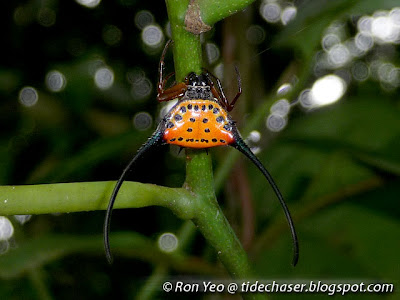
The Curved Spiny Spider (Gasteracantha arcuata) is easily recognised by the pair of long spines extending from the back of its abdomen. The body (excluding the spines) is about 1cm long. It is usually found in mature forests.

The Hasselt's Spiny Spider (Gasteracantha hasseltii) has shorter spines extending from its yellowish abdomen. The body can grow to about 1cm long. This species can be found in wooded areas and secondary forests. All Gasteracantha species generally have three pairs of spines on their abdomen, though the sizes vary and some may not be obvious.

The Kidney Garden Spider (Araneus mitificus) is commonly seen in gardens and wayside vegetation. The body grows to about 1cm long. It is easily recognised by the kidney-like pattern on its back.

Several species of St Andrew's Cross Spiders (Argiope spp.) can be found in Singapore, occurring in a variety of habitats from scrublands and open habitats to mangrove and mature forests. They have the habit of pairing their legs and appearing like a cross, and the females build webs with an obvious X-shaped zigzag band of white silk in the middle. The males build webs with a lace-like centre.
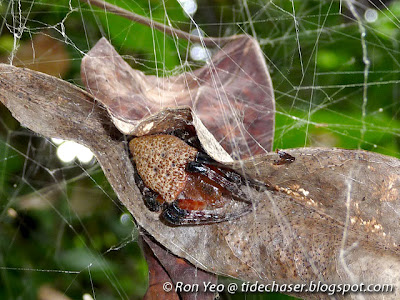
Several species of Tent Spiders (Cyrtophora spp.) can be found in Singapore. They are noted for their three-dimensional, tent-like webs. The above photo features a Red Tent Spider (Cyrtophora unicolor), which often builds a web littered with fallen leaves and other small debris. It usually hides under a curled leaf suspended in the middle of the web. The body of this species is about 2cm long. This species is often found in forest edges and secondary forests.
3. Comb-Footed Spiders (Family Theridiidae)
Most members of this family have a comb of serrated bristles on the last segment of the fourth leg, which helps to draw sticky threads from the spinnerets to wrap and trap their prey. They mostly build three-dimensional webs, but some species are kleptoparasites (animals that steal food from others) that live in the webs of bigger spiders and steal food from them.

The Red Silver Spider (Argyrodes flavescens) is a kleptoparasite which lives in the webs of bigger spiders such as the golden orb-weavers, and steal the food from them. This small red spider has a fat abdomen with silvery markings, and the body seldom exceeds 5mm long.
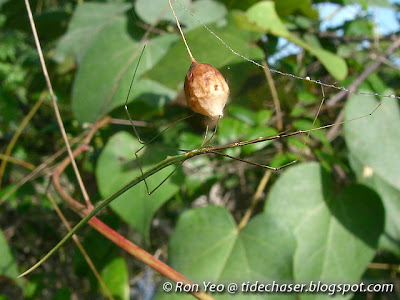
The Whip Spider (Argyrodes flagellum) is often overlooked as it appears like a small twig stuck to its web, which is just a simple Y-shaped structure. They are quite common in coastal forests and scrublands. The body gets to about 2-3cm long.
4. Big-jawed Spiders (Family Tetragnathidae)
Members of this family often have elongate bodies with long legs and well-developed jaws. The jaws of the males are equipped with a spur to lock the jaws of the female while mating.
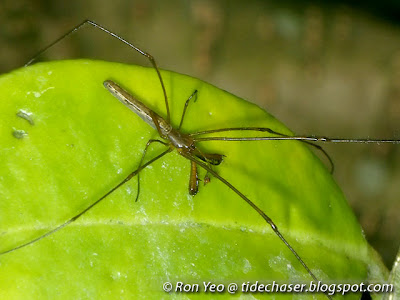
The Mangrove Big-jawed Spider (Tetragnatha josephi) is one of the many big-jawed spiders that can be found in Singapore. As the common name implies, this species is usually found in mangrove forests. The body is about 1cm long.
5. Lynx Spiders (Family Oxyopidae)
Lynx spiders can be recognised by their eye arrangement, in which six of the eight eyes form a hexagon. They have long legs with long, almost erect spines. They are mostly agile hunters with keen eyesight, seeking prey in the day. They have three claws at the tip of each leg.

The above photo features an unknown female lynx spider guarding an egg-sac that was attached to the fruiting stem of a tall grass.
6. Wolf Spiders (Family Lycosidae)
Wolf spiders generally hunt on the ground, and can be recognised by their eyes which are in three rows with four eyes in the first row, and two eyes in each of the other two rows.? They have three claws at the tip of each leg. The females often have a round egg-sac attached to their spinnerets, and sometimes, tiny spiderlings can be seen on their backs. These spiderlings survive on the remaining yolk, and depart after the first moult. Interestingly, the male will wave its pedipalps and do push-ups when it meets a female, possibly a courtship behaviour to signal to the female that it is a suitor and not a prey. Wolf spiders are very commonly in parks and gardens, and are the ones which builds the small webs in grassy areas which sparkles with dew drops in the morning.

The Pond Wolf Spider (Pardosa pseudoannulata) is commonly encountered among the vegetation in both urban and rural ponds. The body usually does not exceed 10cm long. It can be recognised by the dark bands on the back of its cephalothorax, and the ring-like markings on its legs.
7. Nursery Web Spiders (Family Pisauridae)
Nusery web spiders are large hunting spiders.? They have three claws at the tip of each leg. The females are sometimes seen carrying their round egg-sac under their jaws, though it is important to note that they are not the only spiders that do so. The egg-sac will eventually be hidden in a three-dimensional web, called the nursery web, until the eggs hatch.
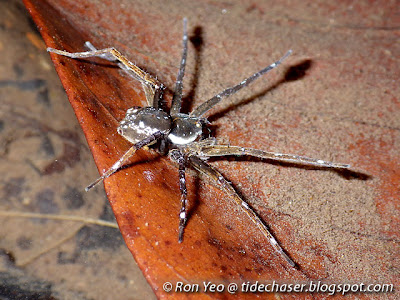
The Fishing Spider (Thalassius sp.) is one of the several nursery web spiders that can be seen in Singapore. It is usually seen near water, either in the vegetation in mangroves or over jungle streams, or on rocks and debris. The body length is about 1.5cm.
8.? Two-Tailed Spiders (Family Hersiliidae)
The two-tailed spiders got their common name from two of their spinnerets, which are relatively long. Their third pair of legs are a lot shorter than their other exceedingly long legs. Each leg has three claws at the tip. They are mostly found on tree trunks or walls, blending nicely with their mottled patterns, capturing their prey by spreading silk while moving quickly around it. When they are disturbed, they can erect the long spinnerets and move rapidly the other side of the tree trunk.
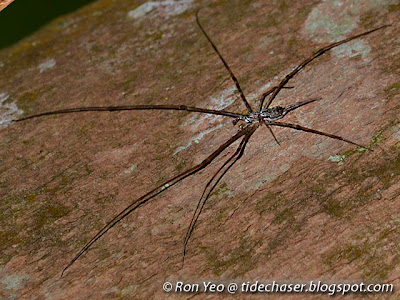
The above Lichen Two-tailed Spider (Hersilia sp.) is usually found on tree trunks, blending in nicely with its flattened body and lichen-like colours and patterns. The body usually does not exceed 2cm long.
9. Huntsman Spiders (Family Sparassidae)
Huntsman spiders are large hunting spiders that usually move sideways. The last two segments of the legs are densely covered in a coat of hair, and at the tip of each leg are two claws.

The Lichen Huntsman (Pandercetes sp.) is sometimes confused with the previous species, but can be distinguished their legs, which are all about the same length, and the lack of the two "tails". Also, each leg has only two claws at the tip. The above photo features one which had caught a cicada. The colour and patterns allow it to blend in nicely with the bark and lichen. The length of the body usually does not exceed 3cm long.
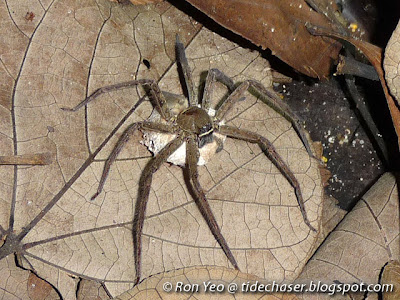
The Domestic Huntsman Spider (Heteropoda venatoria) is commonly found in the forests and sometimes indoor. The females can be recognised by a white band across the front of the head, while the males have a pair of dark brown patches on the back of the head. They mostly feed on cockroaches. This species grows to about 3cm long (body only). The above photo features a female carrying an egg-sac.
10. Wandering Spiders (Family Ctenidae)
Wandering spiders have eyes that are arranged in three rows, with two small eyes in the front row, four eyes in the middle row (two big ones in the middle and a small one on each side), and a pair of large eyes behind.? They have two claws at the tip of each leg, and the first two pairs of legs have numerous spines on them.

The above photo features an unidentified wandering spider which is often seen in the forest.
11. Jumping Spiders (Family Salticidae)
Jumping spiders are so-called for their ability to pounce on their prey, and jump away from danger. Most do not spin webs, but they often produce a single silk thread to anchor themselves to a fixed structure before they jump, much like bungee jumping. Apart from their behaviour, they can be recognised by their eye arrangement - the eyes are arranged in three rows with two pairs in front, a pair of usually tiny ones in the middle, and another pair further back. This arrangement allows them to have a good and very wide field of vision. The middle pair of eyes in the front row are modified such that they give the spiders a telephoto view, while the ones at the sides perform like wide-angle lenses, allowing the spider to detect their prey and judge the distance before they jump. They have two claws at the tip of each leg. Many species of jumpers can be found in Singapore, and hence I will just give two examples here.
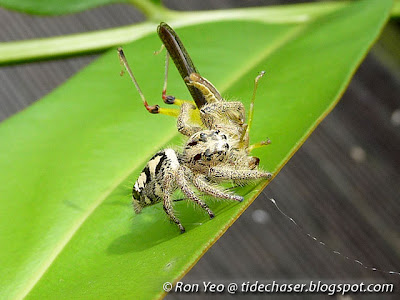
The Heavy Jumper (Hyllus diardi) is relatively big and robust compared to most other jumpers, growing to about 1.5cm long. Its legs are densely covered with hair, and it has two dark bands along the length of its cephalothorax, and a few horizontal bands on its abdomen. It is commonly found near mangroves and in coastal forests.

The above features a female Yellow-Lined Epeus (Epeus flavobilineatus). The male has a yellow abdomen. This species does not get bigger than 1cm long.
12. Crab Spiders (Family Thomisidae)
Crab spiders hunt by ambushing small insects instead of actively searching for prey. They usually remain stationary on flowers or leaves and wait for some unsuspecting insects to land nearby, after which they will grab at them quickly using their first two pairs of legs. These legs are usually longer, stronger and armed with spines, and the spider will hold them out like crab pincers, hence giving them their common name. They also move sideways, like crabs. They have two claws at the tip of each leg.

The Stoliczka's Crab Spider (Thomisus stoliczka) can be recognised by the horn-like projections on the head, and the pair of small bumps on each side of the abdomen. The body is about 0.5cm long. It is commonly seen on grass and shrubs in scrublands and forest edges.
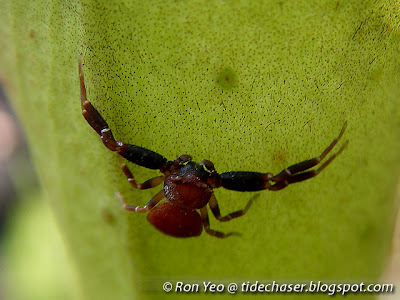
Several species of Misumenops Crab Spiders (Misumenops sp.) are found on pitcher plants, and more than one have been observed to venture inside the pitcher. They presumably attack insects attracted by the sugary liquid secreted by the pitchers.

Not all crab spiders appear short and stout. The above photo features an unidentified crab spider that is found on a ground orchid.
13. Intertidal Spiders (Family Desidae)
These spiders are often seen in intertidal areas during low tide. They are believed to take shelter in cracks and crevices with trapped air when the tide is high. Their hairy body and legs are believed to help trap air as well. When the tide is low, they will emerge to hunt small animals, including small fishes and crustaceans. Its relatively big fangs inject venom into its prey to paralyse them.
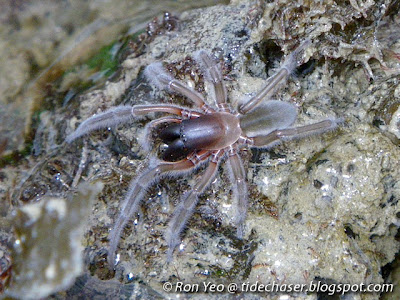
The Marine Spider (Desis martensi) is often seen on reef flats and rocky shores, easily recognised by its brownish coloration and big fangs. The body gets to about 1cm long.
14. Hairy Mygalomorph Spiders (Family Theraphosidae)
Spiders from this family are usually large and hairy, with prominent jaws projecting forward horizontally from the cephalothorax. They are commonly called tarantulas, though the original spider which was given this name was actually a wolf spider from Europe. The fangs of these spiders point backwards, and if threatened, they will raise the fangs in a defensive mode. They have two pairs of book-lungs on the underside of their abdomen. While most species live on the ground, some species may live in high tree holes.

The Singapore Tarantula (Phlogiellus inermis) is one of several species of tarantulas that can be found in Singapore. The females are often found nesting in burrows at the base of trees or on slopes. The body can reach lengths of about 2cm.
B) Harvestmen (Order Opiliones)
Harvestmen are often confused with spiders as they also have four pairs of walking legs, but unlike the latter, they lack the slender waist between the cephalothorax and the abdomen, and do not have silk glands. Most species have a pair of eyes located at the front of the cephalothorax, though a few have no eyes at all. The chelicerae are pincer-like with three segments, while the pedipalps have six segments. The walking legs have seven segments each, and many have a claw or two at the tip.
Unlike most other arachnids which the males pass sperm packages to the females, male harvestmen have a male reproductive structure to fertilise the female internally. The females usually lay the eggs in cracks underground or among rocks. Most species can produce distasteful secretions to deter predators. Many harvestmen are omnivorous, feeding on both small insects and plant/fungi material. Some species scavenge. They are generally quite harmless to human, since they are not known to be venomous, and their chelicerae are too small to pierce through human skin.
I have very few usable photos of harvestmen from Singapore, and here they are:

The above harvestmen is likely a sclerosomatid harvestman (family Sclerosomatidae), and is commonly seen in our forests. The body is quite short, about 0.5cm long. This is one of the many long-legged harvestmen, and they are commonly called daddy-longlegs due to the long legs. The same name also applies to several species of spiders and craneflies though.
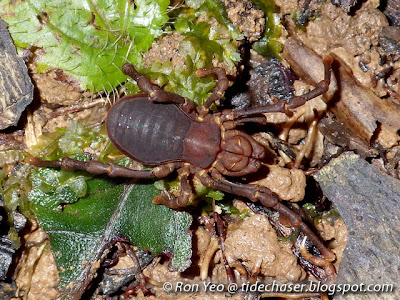
This Sandokan Harvestman (Sandokan sp.) has short, stout legs instead of the long and thin ones. The body is about 1cm long. The genus is named after a fictional pirate of the late 19th century, who was also known as "The Tiger of Malaysia".
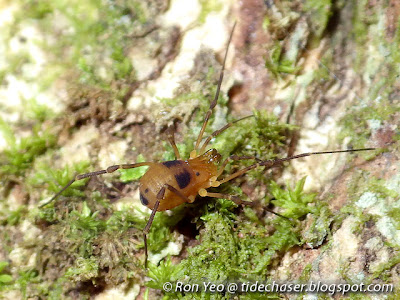
This Biantes sp. can be quite commonly seen in the forests of Singapore, but often overlooked due to its small size. the body is just a few mm long. It can be easily recognised from its yellowish body with two dark, squarish patches on its back.
C) Whip Spiders (Order Amblypygi?)
Whip spiders are so named because their first pair of legs are extremely long, like whips. These long legs carry sensory organs and act like feelers. They have four pairs of eyes. The chelicerae have two segments, and are fang-like for tearing up their prey, which are usually insects or other arachnids. The pedipalps are large and claw-like with six segments, and are used for catching and holding prey. They are generally nocturnal and quite harmless to human. Male whip spiders usually deposit a sperm package on the ground to be picked up by the females. The eggs hatch inside a sac on the underside of the female, and the young are usually carried on her back until they are big enough to hunt on their own.
As I do not know anyone who is familiar with whip spiders in Singapore, the following species which I have seen are not yet identified.

This whip spider is found on the trunk of an old tree in a cemetery. The body is about 2.5-3cm long.
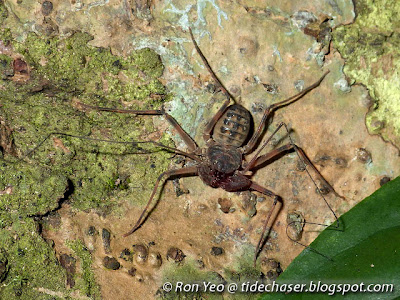
This small whip spider is also on the trunk of a big tree in a secondary forest.
D) Scorpions (Order Scorpiones)
Scorpions are easily recognised by their large pedipalps with pincer-like claws, and a "tail" (or telson) with a venomous sting. While they sometimes use the sting to paralyse their prey, studies suggest that it is more often used for defense purposes. The venom of some species can be fatal, especially for human who are allergic to them, though the local species are not known to be that dangerous. Like other arachnids, scorpions have four pairs of walking legs. They are nocturnal, and usually find prey by touch.

When exposed to ultraviolet light, scorpions are also known to glow due to the presence of fluorescent chemicals in their exoskeleton.

Many species exhibit complicated courtship behaviours, after which the male scorpions will deposit sperm packages on the ground and the females will pick them up with their reproductive parts. The females bear live young, and carry them on their back (see above photo) until their first moult.
Several species of scorpions are known to occur in Singapore, and here are the ones that I have photographed:

The Spotted Scorpion (Lychas scutilus) is possibly the commonest scorpion in Singapore, and the above photo features one which has caught a cockroach. It can reach lengths of about 10cm.

The Black Scorpion (Heterometrus sp.) is sometimes seen in Singapore, often in its burrow. There are probably more than 1 species in Singapore, and it's almost impossible to tell the difference from photos.

The Dwarf Wood Scorpion (Liocheles sp., possibly L. australasiae) is sometimes seen on wooden structures in the forest, or on trees. It has a relatively shorter tail, and is usually not more than 3cm long.
E) Whip Scorpions (Order Thelyphonida)
Whip scorpions got their common name from the whip-like tail extending from the end of the abdomen. The chelicerae are fang-like, while the strong pedipalps have claws at the tip for catching and crushing prey, usually insects and other arthropods. The first pair of legs are longer than the rest, and are used for sensory purposes. They are also commonly called vinegaroons for their ability to spray acids (which smell like vinegar) from glands located near the end of their abdomens. The females usually lay the eggs in a burrow, looking after them without eating. The hatched young will climb onto the back of their mother, and leave after their first moult. The mother dies shortly after.

?The above photo features an unidentified whip scorpion.
F) Pseudoscorpions (Order Pseudoscorpionida)
Pseudoscorpions are quite similar in appearance to the true scorpions, but lack the tail with the venomous sting. They are generally very small, and seldom more than 5mm long. Like the scorpions, they have large, pincer-like pedipalps (may be toothed) for catching prey and for defense - the swollen parts of the pedipalps contain venom glands, which secretes venom to paralyse their prey or to deter predators. They will tear up the prey with their chelicerae. The males usually deposit a sperm package on the ground to be picked up by the females. The eggs hatch inside a sac on the underside of the female. Pseudoscorpions are able to produce silk from a gland in their jaws, and are known to make silk nests in which they hibernate, moult and brood the young. While most pseudoscorpions are found in the forest, hiding in cracks and crevices, some species lives in the intertidal zone and may share the burrows of crabs and other shore animals.
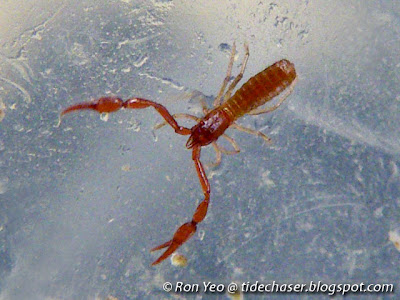
The above photo features the Intertidal Pseudoscorpion (Parahya submersa) which is sometimes found in the intertidal areas of Singapore.
G) Ticks & Mites (Subclass Acari)
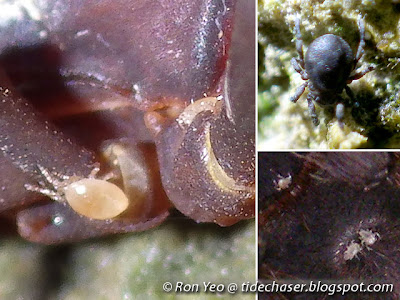
This group used to be an arachnid order, but recent phylogenetic studies have shown that it is more accurate to be a subclass, and many of the previous families have been elevated to become orders. It is a very diverse group, but ticks and mites generally have a body without any distinctive divisions, and a short abdomen. The chelicerae are usually adapted for piercing and sucking, and appear pincer-like. Many species are pests of plants (affecting the growth or causing galls) and stored food, or parasites that feeds on the blood of other animals. Some may feed on dead skin and live as commensals on other animals. Many mites and ticks, however, are carrier of diseases, or trigger allergic reactions in human. Most species are less than 1mm long, but those that parasitise mammals and feed on their blood can grow up to about 1cm long. The main picture features some ticks on a harvestman, the top-right picture features a tick on the stem of a tree, while the bottom-right picture features a few mites on a spider.
Other Arachnids
Other arachnid groups that can be seen in Singapore include the microwhip scorpions (order Palpigradi) and schizomids (order Schizomida), which I do not have photos of local examples yet. I will update with more details when I managed to photograph them.
References
- Bartlett, T. & J. VanDyk. 2003. BugGuide. Retrieved May 24, 2013, http://bugguide.net.
- Burnie, D. 2001. Animal. London: Dorling Kindersley. 624 pp.
- Ecological Research & Development Group. The Horseshoe Crab. Retrieved May 24, 2013, http://www.horseshoecrab.org
- Koh, J. K. H. 1989. A Guide to Common Singapore Spiders. Singapore Science Centre, Singapore. 160 pp.
- McGavin, G. 2000. Dorling Kindersley Handbooks: Insects, spiders and other terrestrial arthropods. London: Dorling Kindersley. 255 pp?
- Ng, P. K. L. & N. Sivasothi (eds.), 1999. A guide to the mangroves of Singapore II: animal diversity. Singapore Science Centre. 168p.
- Ng, P. K .L., R.T. Corlett & H.T.W. Tan (eds.). 2011. Singapore Biodiversity: An Encyclopedia of the Natural Environment and Sustainable Development. Singapore: Editions Didier Millet. 552 pp.
Source: http://tidechaser.blogspot.com/2013/06/spiders-scorpions-arachnida-singapore.html
superbowl ads Super Bowl Ads 2013 Buffalo Wild Wings Superbowl Start Time Jim Harbaugh Who Won The Superbowl Super Bowl Halftime Show 2013
No comments:
Post a Comment
Note: Only a member of this blog may post a comment.